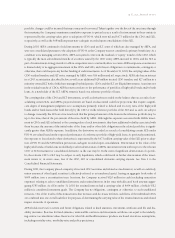American Express 2003 Annual Report Download - page 74
Download and view the complete annual report
Please find page 74 of the 2003 American Express annual report below. You can navigate through the pages in the report by either clicking on the pages listed below, or by using the keyword search tool below to find specific information within the annual report.
(p.72_axp_ financial review)
Risk Management
AEB employs a variety of financial instruments in managing its exposure to fluctuations in interest and currency rates. Deriv-
ative instruments consist principally of foreign exchange spot and forward contracts, foreign currency options, interest rate
swaps, futures and forward rate agreements. Generally, they are used to manage specific interest rate and foreign exchange
exposures related to deposits, long-term debt, equity, loans and securities holdings. At December 31, 2003, interest rate
products with notional amounts totaling approximately $12.2 billion and $0.3 billion for trading and non-trading purposes,
respectively, were outstanding. Notional amounts outstanding at December 31, 2003 for foreign currency products were
approximately $28.8 billion and $5.0 billion for trading and non-trading purposes, respectively. Additionally, equity prod-
ucts with notional amounts of $830 million were outstanding at December 31, 2003.
The negative effect of a 100 basis point increase in interest rates on AEB’s pretax earnings would be $42 million and $19
million at December 31, 2003 and 2002 (including the impact of pretax earnings related to the joint venture with AEFA),
respectively. The effect on earnings of a 10 percent change in the value of the U.S. dollar would be negligible and, with respect
to translation exposure of foreign operations, would result in a $9 million and $16 million pretax impact to equity as of
December 31, 2003 and 2002, respectively.
AEB utilizes foreign exchange and interest rate products to meet the needs of its customers. Customer positions are usually,
but not always, offset. They are evaluated in terms of AEB’s overall interest rate or foreign exchange exposure. AEB also takes
limited proprietary positions. Potential daily exposure from trading activities is calculated using a Value at Risk methodol-
ogy. This model employs a parametric technique using a correlation matrix based on historical data. The Value at Risk mea-
sure uses a 99 percent confidence interval to estimate potential trading losses over a one-day period. The average Value at
Risk for AEB was less than $1 million for both 2003 and 2002.
Asset/liability and market risk management at AEB are supervised by the Asset and Liability Committee, which comprises
senior business managers of AEB. It meets monthly and monitors: (i) liquidity, (ii) capital exposure, (iii) capital adequacy,
(iv) market risk and (v) investment portfolios. The committee evaluates current market conditions and determines AEB’s
tactics within risk limits approved by AEB’s Board of Directors. AEB’s treasury and risk management operations issue poli-
cies and control procedures and delegate risk limits throughout AEB’s regional trading centers.
CORPORATE AND OTHER
Corporate and Other reported net expenses of $214 million, $176 million and $187 million in 2003, 2002 and 2001, respec-
tively. 2001 results include $14 million ($9 million after-tax) of the restructuring charges noted earlier. Included in
2002 results were the final preferred stock dividends from Lehman Brothers totaling $69 million ($59 million after-tax)
compared with $46 million ($39 million after-tax) in 2001. The dividends were offset by business building initiatives in
each year.
OTHER REPORTING MATTERS
Accounting Developments
In July 2003, the AICPA issued Statement of Position 03-1, “Accounting and Reporting by Insurance Enterprises for Certain
Nontraditional Long-Duration Contracts and for Separate Accounts” (SOP 03-1). The Company is currently evaluating its
impact, which, among other provisions, requires reserves related to guaranteed minimum death benefits included within the
majority of variable annuity contracts offered by AEFA. SOP 03-1 is required to be adopted on January 1, 2004, and its impact
will be recognized as a cumulative effect of change in accounting principle in the Company’s first quarter 2004 Statement of
Income. See AEFA’s Impact of Recent Market-Volatility on Results of Operations section of the Financial Review for further
discussion.
Forward-Looking Statements
This Annual Report includes forward-looking statements, which are subject to risks and uncertainties. The words “believe,”
“expect,” “anticipate,” “optimistic,” “intend,” “plan,” “aim,” “will,” “may,” “should,” “could,” “would,” “likely,” and similar
























